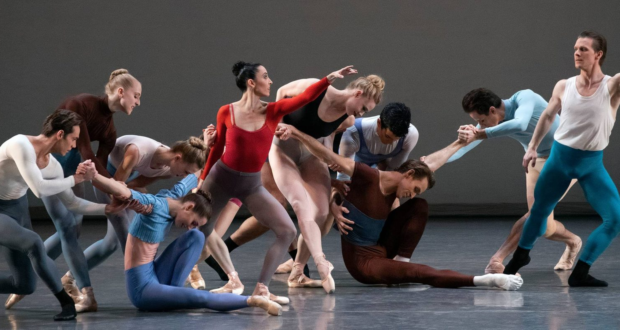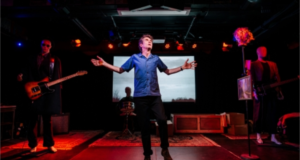Fluid movements, diamond shapes and camouflage leotards mirror the evolution of dance vocabulary from neoclassical ballet to break danceSummary
Rating
Good
New York City Ballet, founded by George Balanchine in 1948, has now danced uninterruptedly for seventy-five seasons: among their many strengths is constant evolution, as displayed in this mixed bill of four pieces across a period from 1972 to 2022, which differ starkly from each other.
Rotunda is choreographed by Justin Peck and danced to music by Nico Muhly. Its style suggests rehearsal/performance and solo/ensemble. Clad in practice session wear, a dozen dancers move in formations. Similar, but not identical, the sequence of movements are danced by each formation not in synchronicity but as if in a fugue, with partial overlap. Casual demeanours and pauses juxtapose with impressive fine movement in both group and solo performance. We can barely tell when the dancers are in rehearsal and when in performance mode, as they seamlessly move between the two. Seemingly, that is precisely the point Peck wants to make: when a dancer moves, they will always be recognisable as a dancer, moving with elegance and control at all times.
Next is Duo Concertant, choreographed by Balanchine to music by Igor Stravinsky. Think of a male and female duet, where a short tutu, en pointe footwork and precise geometric figures refer to the same classical ballet tradition of the late 19th century that produced Giselle and Swan Lake. Balanchine modernised that style, giving it a crisp, almost staccato rhythm, and challenging the ethereal sylph, damsel-in-distress trope for the female dancing body. The movements of both female and male dancer are identical and symmetrical: there are no arm or upper body positions that are specifically feminine or figures that only the male dancer performs. Other than body shapes, toe dancing for her and the occasional lift for him, nothing else differs. Truly a ballet for an equal couple and in 1972 it would have struck a note. There is equality also between dance time and music time, as pianist and violinist are on stage with the dancers, who spend half of the piece completely still, listening intently to the musicians perform.
The standout feature of Gustave Le Gray No.1, choreographed by Pam Tanowitz, to music by Caroline Shaw, is the shape and the flow of the four dancers’ red outfits, designed by Reid Bartelme and Harriet Jung. The dancers’ moves respond to the fabric and to each other in equal measure, just like the viewer is drawn to both the movements of the dancers’ legs and to the flow of the double limbs of fabric attached to them. The role these costumes play is utterly integral to the piece: they do not hide, nor distract from the bodies, but multiply and amplify their movements, mirroring the same grace, fluidity and suppleness of the dancer. As with the classic tutu shapes, these full-body costumes will live on in dance history as a visual delight as well as the new paradigm for contemporary focus on a dancer’s organic and flowing movement.
The closing piece, Love Letter (On Shuffle), choreographed by Kyle Abraham to music by James Blake, is a heterogeneous amalgamation of an entire century of dance vocabulary, dazzling the audience with movements borrowed from classic ballet repertoire, Balanchine’s Nutcracker, street and break dance, and ethnic African movement. It even incorporates a subtle, but recognisable, Beyoncé body roll. The costumes too, designed by Giles Deacon, borrow from a century of dance styles: in matching camouflage print, these range from knee-length and short tutus, to backless leotards rimmed with ruffles and bows, complemented by a full crest of feathers.
The New York City Ballet does not let its past get in the way of the future. The company moves fearlessly towards it, prepared to take risks and to let go of the most revered dance canons. This mixed bill shows that it also knows how to take an audience along for the journey.
Choreography by: Justin Peck, George Balanchine, Pam Tanowitz, Kyle Abraham
Music by: Nico Muhly, Igor Stravinsky, Caroline Shaw, James Blake,
This event has now completed its run at Salder’s Wells.
 Everything Theatre Reviews, interviews and news for theatre lovers, London and beyond
Everything Theatre Reviews, interviews and news for theatre lovers, London and beyond



